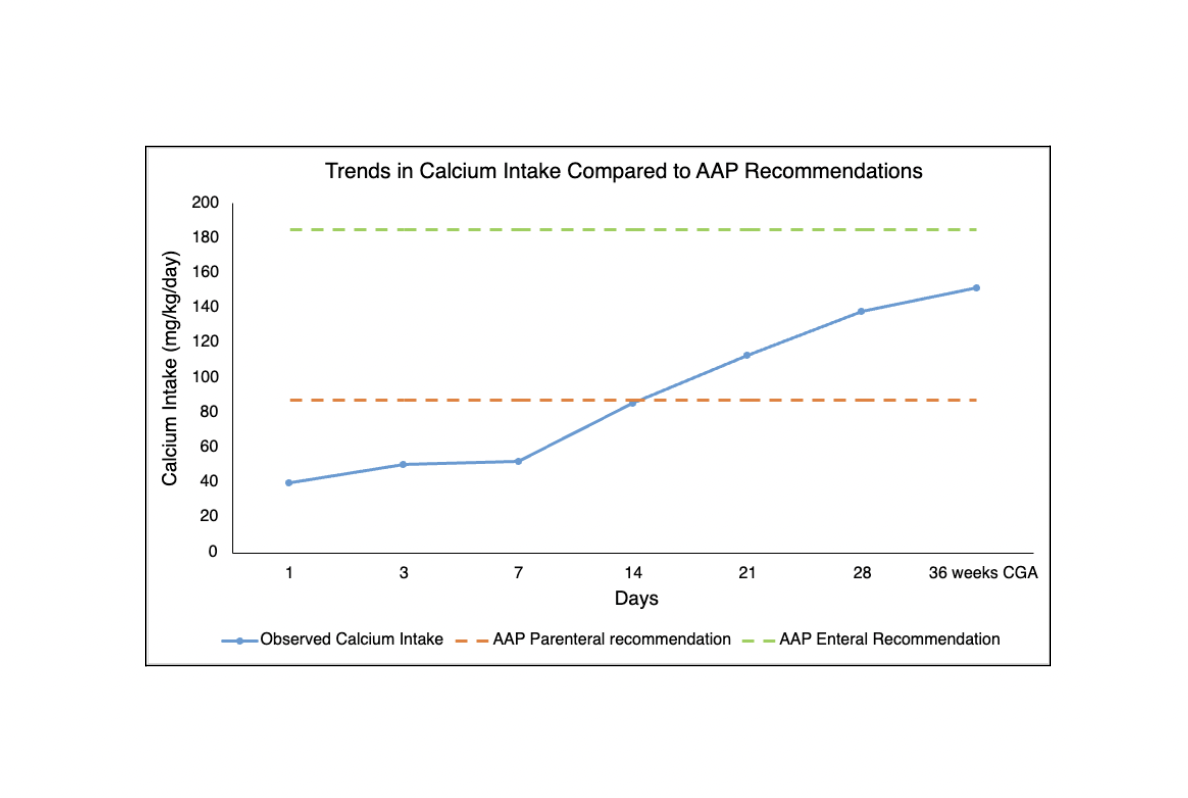Neonatal Fetal Nutrition & Metabolism 4
Session: Neonatal Fetal Nutrition & Metabolism 4
644 - Parenteral and enteral intake of calcium and phosphorus in extreme preterm infants-are we doing enough?
Monday, April 28, 2025
7:00am - 9:15am HST
Publication Number: 644.5718
Nupur Assudani, Children's Hospital of Michigan, DETROIT, MI, United States; Hassan Shaban, Children's Hospital of Michigan, Detroit, MI, United States; Sanjay Chawla, Children's Hospital of Michigan, TROY, MI, United States

Nupur Assudani, MD (she/her/hers)
Neonatal-Perinatal Medicine Fellow
Children's Hospital of Michigan
DETROIT, Michigan, United States
Presenting Author(s)
Background: Extremely preterm infants are at high risk for metabolic bone disease (MBD) due to interrupted intrauterine mineral accretion, particularly calcium and phosphorus, critical for bone health. Despite advances in neonatal care, MBD remains common in extremely low-birthweight (ELBW) infants, with a prevalence of up to 40% in ELBW cases. Current Academy of Paediatrics (AAP) guidelines recommend daily parenteral calcium (75-100 mg/kg/day and phosphorus (50-80 mg/kg/day) intake, and enteral intake of calcium (150 to 220 mg/kg/day) and phosphorus (75 to 140 mg/kg/day). Optimizing mineral intake is crucial to reducing MBD risk and improving long-term bone health.
Objective: This study evaluates the adequacy of calcium and phosphorus intake via parenteral and enteral nutrition in extremely preterm infants in the first month of life relative to AAP guidelines. Additional objectives include analyzing plasma calcium and phosphorus levels and assessing MBD risk through alkaline phosphatase (ALP) levels.
Design/Methods: This retrospective cohort study examined data from infants born between January 2017 and June 2023 with gestational ages between 22 0/7 and 27 6/7 weeks at a Level III NICU. Parenteral and enteral intake data on calcium, phosphorus, calories, and protein were collected at intervals in the first month and at 36 weeks corrected gestational age (CGA). Serum calcium, phosphorus, and ALP levels were also assessed at similar intervals. Demographic and clinical variables included maternal antenatal steroids, neonatal diuretic use, and outcomes such as bronchopulmonary dysplasia and sepsis. Median and interquartile ranges (IQR) summarized continuous variables; categorical data were presented as frequencies and percentages.
Results: Among 61 preterm infants, the median gestational age was 25 weeks, and the median birth weight was 655 grams. Calcium intake increased from a median of 39.9 mg/kg on Day 1 to 151.5 mg/kg by discharge, while phosphorus intake rose from 22.6 mg/kg to 87.1 mg/kg. Intakes often fell short of AAP recommendations early in life (Image 1, 2). Serum calcium and phosphorus were generally within target ranges, but ALP levels—an MBD marker—were elevated, with 42% of infants exceeding 600 U/L during their stay, indicating MBD risk.
Conclusion(s): Calcium and phosphorus intake in extremely preterm infants frequently falls below guidelines in early life, potentially increasing MBD risk as indicated by high ALP levels, though serum calcium and phosphorus levels remain in normal ranges. Quality improvement initiatives are needed to improve calcium and phosphorus intake adequacy to reduce the risk of MBD.
Table 1: Demographic and clinical characteristics of the study population
.png) This table summarizes maternal, birth, and neonatal factors in the study cohort of extremely preterm infants.
This table summarizes maternal, birth, and neonatal factors in the study cohort of extremely preterm infants. Image 1: Trends in Calcium Intake in Preterm Infants Compared to AAP Recommendations
 This graph tracks the observed calcium intake (mg/kg/day) in extremely preterm infants from day one to 36 weeks of corrected gestational age (CGA), comparing it to the American Academy of Pediatrics (AAP) recommendations for parenteral (orange dashed line) and enteral (green dashed line) calcium intake. While the observed intake (blue line) rises over time, it initially falls below both recommended levels, eventually surpassing the parenteral recommendation by day 14 but remaining below the enteral recommendation.
This graph tracks the observed calcium intake (mg/kg/day) in extremely preterm infants from day one to 36 weeks of corrected gestational age (CGA), comparing it to the American Academy of Pediatrics (AAP) recommendations for parenteral (orange dashed line) and enteral (green dashed line) calcium intake. While the observed intake (blue line) rises over time, it initially falls below both recommended levels, eventually surpassing the parenteral recommendation by day 14 but remaining below the enteral recommendation.Image 2: Trends in Phosphorus Intake in Preterm Infants Compared to AAP Recommendations
.png) This graph shows phosphorus intake (mg/kg/day) in extremely preterm infants from day one to 36 weeks of corrected gestational age (CGA). It compares this intake to the American Academy of Pediatrics (AAP) recommendations for parenteral (orange dashed line) and enteral (green dashed line) phosphorus intake. The blue line indicates that phosphorus intake surpasses the AAP's parenteral recommendation (orange line) by day 21.
This graph shows phosphorus intake (mg/kg/day) in extremely preterm infants from day one to 36 weeks of corrected gestational age (CGA). It compares this intake to the American Academy of Pediatrics (AAP) recommendations for parenteral (orange dashed line) and enteral (green dashed line) phosphorus intake. The blue line indicates that phosphorus intake surpasses the AAP's parenteral recommendation (orange line) by day 21.
